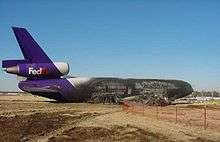FedEx Express Flight 647
 FedEx Flight 647 after the fire. | |
| Accident summary | |
|---|---|
| Date | December 18, 2003 |
| Summary | Pilot error[1] |
| Site | Memphis International Airport, Memphis, Tennessee, United States |
| Passengers | 5 |
| Crew | 2 |
| Fatalities | 0 |
| Injuries (non-fatal) | 2 |
| Survivors | 7 (all) |
| Aircraft type | McDonnell Douglas MD-10-10F |
| Aircraft name | Amber |
| Operator | FedEx Express |
| Registration | N364FE |
| Flight origin | Metropolitan Oakland International Airport, Oakland, California |
| Destination | Memphis International Airport, Memphis, Tennessee |
FedEx Express (FedEx) Flight 647 was a flight between Metropolitan Oakland International Airport (OAK), Oakland, California and Memphis International Airport (MEM), Memphis, Tennessee that crashed during landing on December 18, 2003.[2]
Aircraft and flight crew
The aircraft involved in the incident was a McDonnell Douglas MD-10-10F (registration N364FE).[1]:viii The MD-10 is an upgraded variant of the McDonnell Douglas DC-10 three-engine wide-body aircraft. At the time of the accident, the aircraft had a total of approximately 65,375 flight hours.[1]:10
The flight had an experienced flight crew; the captain had about 21,000 total fight hours, including 2,602 flight hours in the MD-10 and MD-11 series of aircraft, while the first officer had about 15,000 total fight hours, including 1,918 hours in the MD-10/MD-11.[1]:6
The flight also had aboard 5 off-duty FedEx crew members bound for Memphis.[1]:1
Flight and incident
On December 18, 2003, Flight 647 was scheduled to depart Oakland for Memphis at 08:10 central standard time, and after a brief delay due to a package sorting issue, departed for Memphis at 08:32.[1]:1 The departure from Oakland and cruise between Oakland and Memphis were uneventful.[1]:2
The flight touched down at about 12:26 on runway 36R, and almost immediately the right landing gear collapsed. The plane veered off the right side of the runway, catching fire as it did so. The co-pilot received minor injuries as she evacuated the aircraft, as did one of the five non-revenue FedEx pilots who were on board as passengers. It was later discovered that the non-revenue pilot who activated the slide for the emergency exit had not been adequately trained in its operation, and so accidentally pulled the handle that released the slide as a raft in the event of a landing on water, so that the slide detached from the airplane.[3]
Investigation
The NTSB conducted a full investigation of the accident. It found that although the aircraft had encountered a crosswind during landing, the conditions were well within the safe capabilities of the aircraft. However, it was discovered that the first officer did not properly line up the plane before touchdown, nor did she slow the plane adequately before touchdown, so that the plane came down excessively hard. As the plane came down, due to the crosswind, the right wing suddenly lowered approximately six degrees. This was beyond the design capabilities for the right main landing gear, and it snapped as a result. The NTSB also cited the captain for failing to check the work of the first officer.[4][5][6]
The NTSB further found that FAA Order 8400.10 (Air Transportation Aviation Inspector's Handbook) was deficient in the section addressing assurance of evacuation training for the flight crew.[6]
References
- 1 2 3 4 5 6 7 "Hard Landing, Gear Collapse Federal Express Flight 647 Boeing MD-10-10F, N364FE Memphis, Tennessee December 18, 2003" (PDF). National Transportation Safety Board. May 17, 2005. Retrieved January 30, 2016.
- ↑ "FedEx on for busiest night; crash inquiry continues". Memphis Business Journal. December 22, 2003. Retrieved December 8, 2010.
- ↑ Frances Fiorino (May 22, 2005). "FedEx Crash Highlights Need to Correct Performance Deficiencies". Aviation Week & Space Technology. Retrieved December 8, 2010.
- ↑ "Accident Description". Aviation Safety Network. May 18, 2005. Retrieved December 9, 2010.
- ↑ "Brief of Accident". U.S. National Transportation Safety Board. June 2, 2005. Retrieved December 9, 2010.
- 1 2 "Factual Report". U.S. National Transportation Safety Board. May 20, 2005. Retrieved December 9, 2010.
Further reading
- Bangash, M. Y. H. (2008). Shock, Impact and Explosion: Structural Analysis and Design. シュプリンガー・ジャパン株式会社. p. 53. Retrieved December 9, 2010.